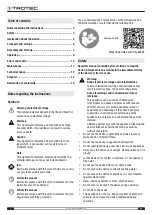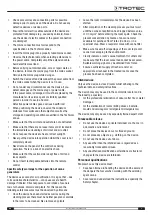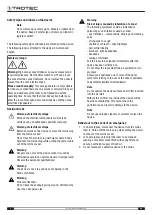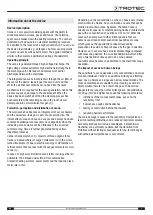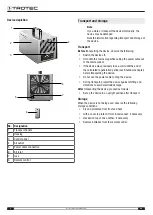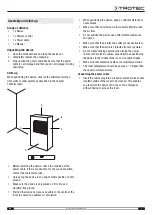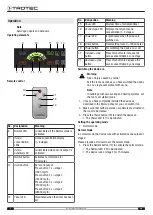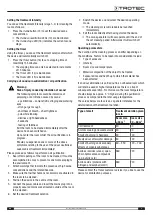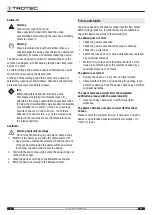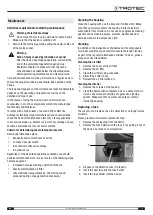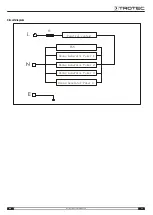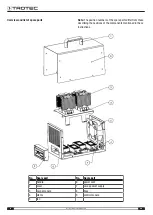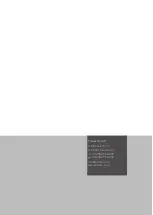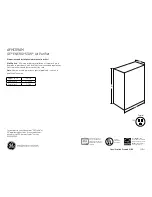
EN
3
Ozone generator Airozon® 28 ECO
•
Check accessories and connection parts for possible
damage prior to every use of the device. Do not use any
defective devices or device parts.
•
Ensure that all electric cables outside of the device are
protected from damage (e.g. caused by animals). Never
use the device if electric cables or the power connection
are damaged!
•
The mains connection must correspond to the
specifications in the Technical annex.
•
Insert the mains plug into a properly fused mains socket.
•
Observe the technical data when selecting extensions to
the power cable. Completely unroll the extension cable.
Avoid electrical overload.
•
Before carrying out maintenance, care or repair work on
the device, remove the mains plug from the mains socket.
Hold onto the mains plug while doing so.
•
Switch the device off and disconnect the power cable from
the mains socket when the device is not in use.
•
Do not under any circumstances use the device if you
detect damages on the mains plug or power cable.
If the power cable is damaged, it must be replaced by the
manufacturer, its service agent or similarly qualified
persons in order to avoid a hazard.
Defective power cables pose a serious health risk!
•
When positioning the device, observe the minimum
distances from walls and other objects as well as the
storage and operating conditions specified in the Technical
annex.
•
Make sure that the air inlet and outlet are not obstructed.
•
Make sure that there are no loose items or dirt located in
the immediate surroundings of air inlet and air outlet.
•
Do not expose the device to heat or direct sunlight.
•
Never put the device into operation whilst the cover is not
completely closed.
•
Never remove the panel of the control box during
operation. There is a risk of an electric shock.
•
Make sure that the suction side is kept free of dirt and
loose objects.
•
Do not insert rechargeable batteries into the remote
control.
Specific safety warnings for the operation of ozone
generators
The device uses ozone for air purification. It is a gas that – due
to its oxidative characteristics – can cause severe health
damage if inhaled. Direct exposure to and intake of ozone is
toxic for humans, animals and plants. For this reason the
following safety measures must be observed by all means:
•
Once the device has been started as well as during the
cleaning process there must be neither people nor animals
in the room to be cleaned. Also remove any plants.
•
Leave the room immediately once the device has been
started.
•
After completion of the cleaning process you must wait
until the ozone concentration has dropped below a value
of 0.2 mg/m³ before entering the room again. Check the
present concentration by means of an ozone meter
available for purchase from Trotec (Oz-One) or in a
specialist shop. Wear a respirator mask with ozone filter.
•
Make sure to seal off all openings of the room to prevent
ozone from escaping to the environment.
•
Clearly indicate a room's ozone treatment for others and
make sure that the room concerned cannot be accessed.
Suitable warning signs may be obtained from Trotec.
•
Ensure a sufficient supply of fresh air and/or an
appropriate air exhaust in the treated rooms once the
process has been completed.
Intended use
Only use the device in closed rooms whilst adhering to the
technical data and safety instructions.
The device may only be used in the commercial sector and in
the industry, especially
•
for the professional elimination of odours after fire or water
damages,
•
for the sterilization of rooms (killing viruses, bacteria,
mould and carcinogenic / allergenic microorganisms).
The device may only be used by especially trained expert staff.
Foreseeable misuse
•
Do not use the device as private individual or at home / in
a domestic environment.
•
Do not place the device on wet or flooded ground.
•
Do not place any objects, e.g. clothing, on the device.
•
Do not use the device out of doors.
•
Any use other than the intended use is regarded as a
reasonably foreseeable misuse.
•
Any unauthorised modifications, alterations or structural
changes to the device are forbidden.
Personnel qualifications
People who use this device must:
•
have been trained in handling the device and be aware of
the dangers that occur when working with the oxidising
agent ozone.
•
have read and understood the instructions, especially the
Safety chapter.


